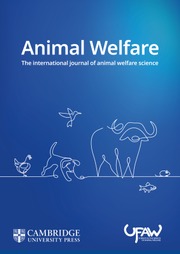Article contents
Electroencephalographic responses of anaesthetised pigs to intraperitoneal injection of sodium pentobarbital
Published online by Cambridge University Press: 01 January 2023
Abstract
Small laboratory animals are commonly euthanased via intraperitoneal (IP) injection of sodium pentobarbital. However, there is concern that animals may experience pain prior to loss of consciousness with this delivery route. The present study investigated electroencephalographic (EEG) nociceptive responses of anaesthetised pigs to IP sodium pentobarbital injection using an established minimal anaesthesia model. Thirty commercial white line entire male pigs aged 10-15 days were minimally anaesthetised with halothane in oxygen. Following 10 min of baseline EEG data collection, pigs had their tails docked using side-cutters and, after a further 5-min interval, were euthanased via IP injection of sodium pentobarbital (250 mg kg-1). The summary variables median frequency (F50), 95% spectral edge frequency (F95) and total power (PTOT) were derived from the EEG data. For each variable in each pig, means were calculated for the following 60-s periods: immediately prior to tail-docking (baseline 1); immediately prior to pentobarbital injection (at least 4 min after docking; baseline 2); and for two consecutive 60-s periods immediately following pentobarbital injection (P1 and P2). Statistical analyses revealed no differences between the two baseline periods, indicating that transient EEG changes induced by tail-docking had resolved prior to pentobarbital injection. IP pentobarbital injection induced a significant increase in F50 and decrease in PTOT of the EEG during P1. This response is characteristic of acute nociception, indicating that conscious pigs likely perceive IP sodium pentobarbital as painful in the period prior to loss of consciousness.
Information
- Type
- Articles
- Information
- Copyright
- © 2018 Universities Federation for Animal Welfare
References
- 6
- Cited by

